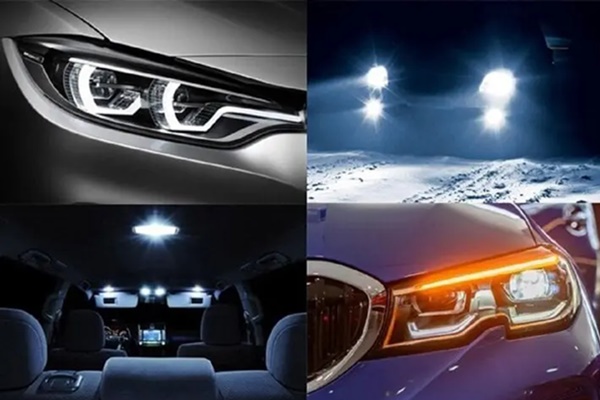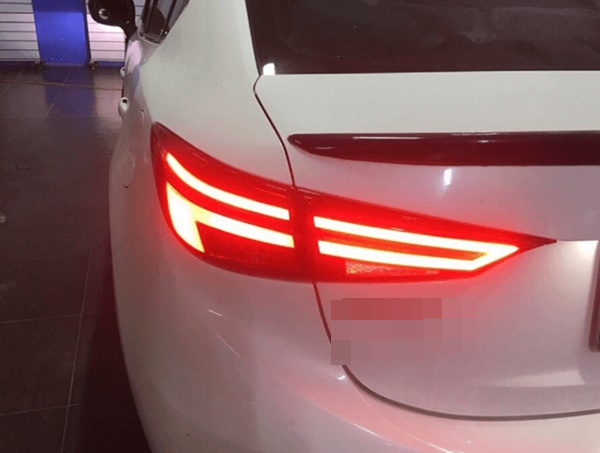This significantly affects the safety of vehicles on the road. In many cases, drivers are even fined by traffic police for improper use of headlights.
Therefore, understanding the function as well as how to turn on, turn off, and adjust the headlights, taillights, turn signals, or fog lights on a car is considered an important lesson for “new talents”.
Types of lights on a car
Headlights and high beams
The high beams have a low angle of projection, allowing the driver to observe the road condition within a close range. They are used when driving at low speed, in urban areas, and residential areas.

Car headlights systems and what new drivers need to know. (Illustrative photo).
The headlights have a longer projection distance, a stronger light intensity, and a higher angle of projection, allowing the driver to observe obstacles from a distance. Drivers usually use this type of light when driving on highways at night.
Taillights
The taillights are located at the rear of the vehicle. They emit red light to notify the vehicles behind of the presence of the moving car. This allows the vehicle behind to maintain an appropriate distance.
Fog lights
Fog lights are placed in a low position, below the front bumper or the rear of the vehicle. They are used to provide illumination in bad weather conditions such as rain, fog, etc.
The fog light system operates independently of the headlights and can be used when the headlights are not effective in bad weather.
Turn signals
Turn signals are located at the front and rear of the vehicle, next to the headlights and taillights. They indicate the direction in which the vehicle is turning to other vehicles.
Brake lights
Brake lights are part of the overall taillight assembly. They illuminate brighter than normal lights when you step on the brake pedal, indicating to other drivers that you are slowing down or stopping.
Emergency lights
Emergency lights are displayed at both the front and rear of the vehicle through simultaneous turn signals on both sides. Emergency lights signal to other drivers that the vehicle is experiencing a problem.
Cabin lights
The cabin lights system includes roof lights, control panel lights, ABS lights, oil pressure warning lights, engine error warning lights, etc. Each type has its own function.
How to adjust the lights on a car
Depending on the arrangement by the manufacturer, there are two ways to adjust the lights: using the control lever on the left side of the steering wheel or using the integrated rotary knob on the dashboard near the driver’s door.

Car taillights. (Illustrative photo).
To turn on the front lights, the driver simply needs to turn the control switch to the headlight symbol (usually with three horizontal lines representing the headlights). When turned on, the front lights of the car will usually default to the low beam mode. To switch to the high beam mode, the driver only needs to push the integrated control lever on the left side of the steering column forward.
At this time, the dashboard will display a blue light symbol (three horizontal lines representing the high beams) to indicate that the headlights are on. Conversely, when pulling the lever backward (towards the driver), the lights will switch to the low beam mode.
In some cases, to signal a warning to the vehicle in front, the driver can flash the high beams by pushing or pulling the integrated control lever on the left side of the steering column at least 1-2 times.
When changing lanes or changing direction, the driver also uses the integrated control lever on the left side of the steering column to activate the turn signal. Specifically, to turn on the right turn signal, the driver pushes this lever up. Conversely, when pushing down, the left turn signal will activate.
Similarly, to turn on the fog lights, daytime running lights (DRL), the driver only needs to turn the control switch to the respective light symbol. Each car has a different design for the light adjustment switch, so users should read the accompanying instruction manual to fully understand.
For cars with a rotary knob, the driver will have a more intuitive and easy-to-operate view compared to the traditional control lever. At this time, the traditional control lever on the left side of the steering column is only used to switch between high beam and low beam modes and activate the turn signals.
Notes for using car lights correctly
When driving at night on highways, you can use the high beams, but when encountering oncoming vehicles, you should reduce the speed and switch the high beams to low beams until the oncoming vehicle has passed.
It is advisable to develop the habit of flashing high beams (flashing between high beams and low beams) when changing lanes or overtaking. For cars, high beams are a better way to signal than using the horn because cars are fully enclosed and it is difficult to hear the sound from the horn while driving.
If you observe an oncoming vehicle flashing its high beams, check if your headlights are in the high beam mode. This is something you should keep in mind because oncoming drivers can be dazzled by your high beams, which can lead to loss of control and traffic accidents.
Regularly maintain the car’s headlight system, properly align the light beam of the headlight, and replace the headlights after a period of use to ensure the safest lighting when using the car.
According to VTC News































